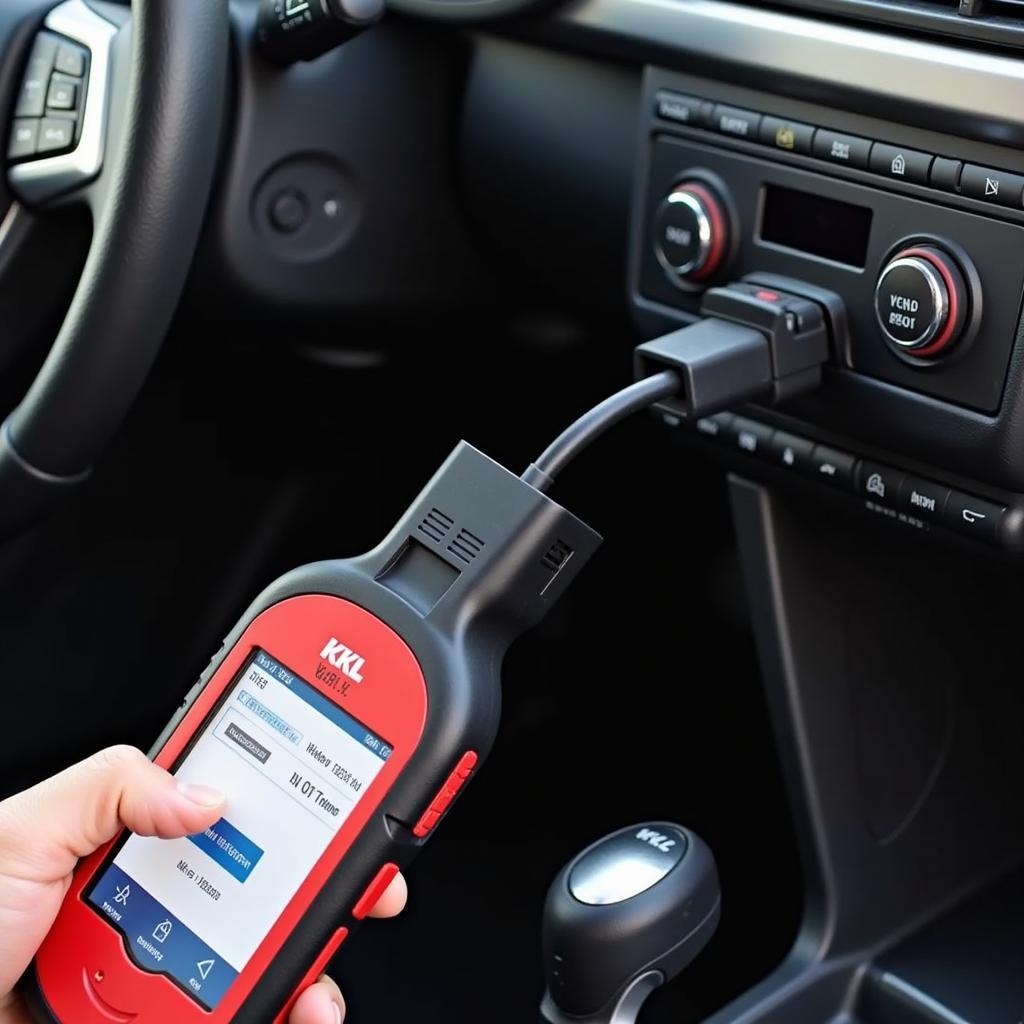Does VCDS have an oscilloscope? This is a common question among automotive enthusiasts and technicians. While VCDS (VAG-COM Diagnostic System) is a powerful diagnostic tool for Volkswagen, Audi, Seat, and Skoda vehicles, it doesn’t have a built-in oscilloscope function. Let’s delve into the capabilities of VCDS and explore alternative solutions for oscilloscope needs.
Understanding VCDS and its Diagnostic Power
VCDS excels at retrieving diagnostic trouble codes (DTCs), providing live data streams from various sensors, and allowing for adaptations and basic settings modifications. It’s a crucial tool for identifying and addressing a wide range of automotive issues, from engine misfires to faulty sensors. However, its focus is primarily on the digital communication network within the vehicle.
Why VCDS Doesn’t Include an Oscilloscope
An oscilloscope is an electronic test instrument that graphically displays varying signal voltages over time. It’s essential for analyzing waveforms and diagnosing complex electrical problems. Integrating an oscilloscope directly into VCDS would significantly increase its complexity and cost. Given VCDS’s primary function as a diagnostic scan tool, incorporating oscilloscope functionality isn’t its core design objective.
When an Oscilloscope Becomes Essential
While VCDS can pinpoint many issues, an oscilloscope is indispensable for diagnosing problems involving:
- Sensor Waveform Analysis: An oscilloscope allows visualizing sensor outputs, like crankshaft or camshaft position sensors, to identify signal anomalies.
- Signal Integrity Issues: Intermittent electrical connections or faulty wiring can be difficult to detect with a scan tool. An oscilloscope can reveal voltage drops or fluctuations that indicate these problems.
- Component Testing: An oscilloscope can be used to test the functionality of various components, such as injectors, ignition coils, and actuators, by analyzing their electrical signals.
How to Use an Oscilloscope with VW/Audi Vehicles
Even though VCDS doesn’t have a built-in oscilloscope, you can still utilize a standalone oscilloscope effectively with your VW or Audi vehicle. Connecting to specific test points within the vehicle’s wiring harness allows you to analyze the relevant signals for diagnosis. Consult the vehicle’s wiring diagrams and repair manuals for proper test point locations.
Choosing the Right Oscilloscope for Automotive Diagnostics
Selecting the appropriate oscilloscope depends on your diagnostic needs and budget. For basic automotive diagnostics, a 2-channel oscilloscope with a bandwidth of at least 50 MHz is often sufficient. More advanced oscilloscopes with features like deep memory and advanced triggering options are beneficial for complex diagnostics.
Alternative Diagnostic Approaches within VCDS
While VCDS lacks oscilloscope functionality, it offers alternative methods for diagnosing certain electrical problems. Live data parameters, for instance, provide real-time sensor readings that can help identify anomalies. Furthermore, measuring blocks within VCDS allow access to specific data points for in-depth analysis.
Combining VCDS with Other Diagnostic Tools
Integrating VCDS with other diagnostic tools creates a powerful diagnostic ecosystem. Using a multimeter alongside VCDS provides a means to measure voltage, resistance, and current, complementing the digital information provided by VCDS.
“While VCDS is invaluable for its code reading and adaptation capabilities, a separate oscilloscope becomes crucial when dealing with intricate waveform analysis and signal integrity issues,” says Robert Hoffmann, Senior Automotive Diagnostics Engineer.
“Using a combination of diagnostic tools, including VCDS, a multimeter, and an oscilloscope, allows for a comprehensive and accurate diagnosis of a wide range of automotive problems,” adds Maria Sanchez, Lead Automotive Technician.
Conclusion: VCDS and Oscilloscopes – A Powerful Partnership
Does VCDS have an oscilloscope? No, but it remains a vital diagnostic tool for VW/Audi vehicles. While VCDS doesn’t provide oscilloscope functionality, it excels in retrieving diagnostic codes, live data, and adaptations. By combining VCDS with a standalone oscilloscope, technicians and enthusiasts can effectively diagnose a broad spectrum of automotive electrical issues. Remember, leveraging the right tools for the job is crucial for accurate and efficient vehicle repair. Does VCDS have an oscilloscope? No, but using it alongside one empowers you with a comprehensive diagnostic approach.
FAQ
- What is VCDS used for? VCDS is a diagnostic software used for Volkswagen, Audi, Seat, and Skoda vehicles.
- Can VCDS program keys? Yes, VCDS can perform key programming functions on supported vehicles.
- How much does VCDS cost? The cost of VCDS varies depending on the license and interface type.
- Can I use VCDS on any car? No, VCDS is specifically designed for VAG vehicles (Volkswagen, Audi, Seat, and Skoda).
- What is an oscilloscope used for in automotive diagnostics? An oscilloscope is used to visualize electrical signals and waveforms in automotive systems.
- Where can I buy an oscilloscope suitable for automotive use? Automotive oscilloscopes can be purchased from various electronics retailers and online suppliers.
- Are there any free alternatives to VCDS? There are some limited free diagnostic software options available, but VCDS offers a comprehensive feature set.
Common Situations Requiring an Oscilloscope:
- Intermittent misfires that don’t trigger a DTC.
- Suspected faulty crankshaft or camshaft position sensors.
- Issues with fuel injectors or ignition coils.
- Diagnosing wiring harness problems.
Other Helpful Resources on CARDIAGTECH:
- “Understanding Diagnostic Trouble Codes (DTCs)”
- “A Guide to Using VCDS for Beginners”
- “Top 5 Essential Automotive Diagnostic Tools”
Need help? Contact us via WhatsApp: +1 (641) 206-8880, Email: CARDIAGTECH[email protected] or visit us at 276 Reock St, City of Orange, NJ 07050, United States. We offer 24/7 customer support.

